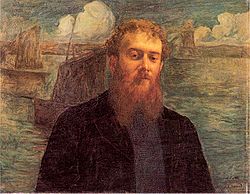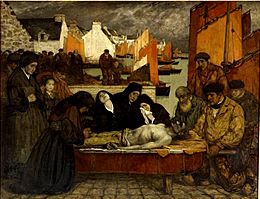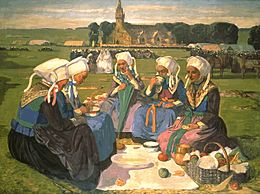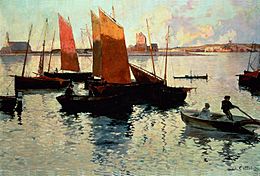Charles Cottet facts for kids
Quick facts for kids
Charles Cottet
|
|
|---|---|

Émile-René Ménard's Portrait de Cottet (1896)
|
|
| Born |
Charles Cottet
12 July 1863 |
| Died | 20 September 1925 (aged 62) Paris
|
| Nationality | French |
| Known for | Painting |
|
Notable work
|
Au pays de la mer. Douleur, 1908–09 Petit village au pied de la falaise, 1905; Montagne, 1900–10 |
| Movement | Post-Impressionism |
Charles Cottet (born July 12, 1863 – died September 20, 1925) was a famous French painter. He was born in Le Puy-en-Velay and later passed away in Paris.
Cottet was known for his unique style, which was part of the Post-Impressionism art movement. He often painted dark and emotional scenes. His favorite subjects were the countryside of Brittany and beautiful seascapes.
He also led a group of artists called the Bande noire, which means "Black Gang." They were also known as "Nubians." This name came from their use of darker colors in their paintings. This was different from the brighter colors used by Impressionist painters. Charles Cottet was also friends with famous artists like Auguste Rodin.
Contents
About Charles Cottet's Life
Charles Cottet studied art at the École des Beaux-Arts. He also learned from well-known artists like Puvis de Chavannes and Roll. Cottet also attended the Académie Julian, another art school. Some of his classmates there formed a group called Les Nabis.
Cottet traveled a lot during his life. He painted scenes from Egypt, Italy, and around Lake Geneva. However, he became most famous for his paintings of the Brittany coast. These paintings were often serious and impressive. They showed the daily life of people living by the sea.
His Artistic Journey
Cottet showed his art at the Salon in 1889. But a trip to Brittany in 1886 truly changed his art. He found his passion there. For the next 20 years, he focused on painting scenes of rural life and harbors. He showed the culture of Brittany, which was quite different from Paris.
He was especially known for his dark paintings of Breton harbors at dawn. He also painted emotional scenes of Breton fishermen's lives.
Cottet was good friends with Charles Maurin. His art group included painters like Félix-Émile-Jean Vallotton. Cottet is often linked to the Pont-Aven School, which also focused on seaside scenes. However, Vallotton once painted Cottet as a leader of Les Nabis alongside other famous artists.
Cottet was clearly the leader of his own group, the Bande noire, in the 1890s. This group included artists like Lucien Simon and André Dauchez. They were all inspired by the realistic style and dark colors of Courbet.
Where to See His Art
You can find Charles Cottet's paintings in many art museums around the world. These include:
- The Pushkin Museum of Fine Arts in Moscow.
- The British Museum in London.
- The National Gallery of Art in Washington D.C.
- The Musée d'Orsay in Paris.
- The Hermitage Museum in St. Petersburg.
- The University of Michigan Museum of Art.
- The Ohara Museum of Art in Japan.
- The Smithsonian American Art Museum.
- The National Museum of Western Art.
- The Zimmerli Art Museum.
- The Fine Arts Museums of San Francisco.
- The Metropolitan Museum of Art in New York.
- The Musée Rodin in Paris.
Some of His Famous Works
- 1908–09: Au pays de la mer. Douleur (also called Les victimes de la mer), found at the Musée d'Orsay.
- 1905: Petit village au pied de la falaise, at the Musée Malraux in Le Havre.
- 1900–10: Montagne, also at the Musée Malraux in Le Havre.
- 1896: View of Venice from the Sea, at the Hermitage Museum.
- 1896: Seascape with Distant View of Venice, also at the Hermitage Museum.
- 1896: Portrait de Cottet, at the Musée d'Orsay.
See also
 In Spanish: Charles Cottet para niños
In Spanish: Charles Cottet para niños
- List of the works of Charles Cottet depicting scenes of Brittany




